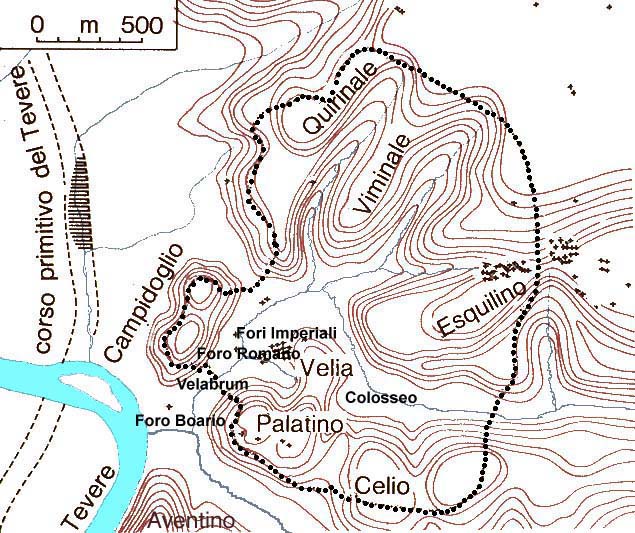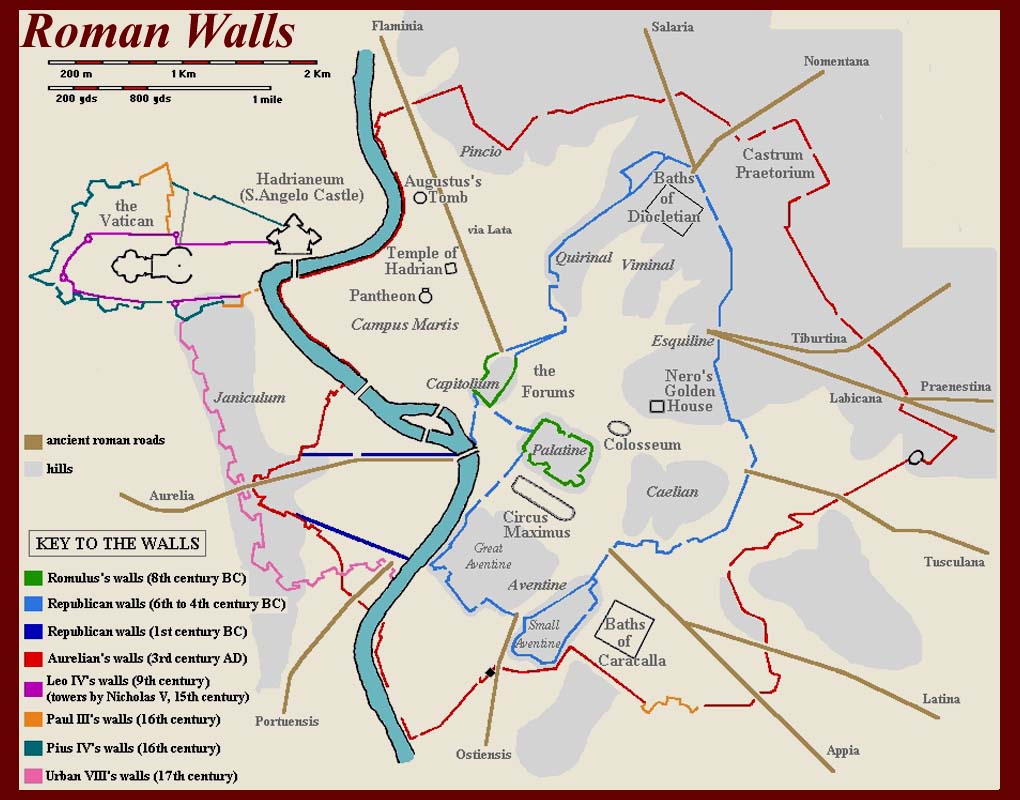Basic Rome City TopographyTraditionally Rome is said to be founded on seven hills, but the history and the topography of Rome is a bit more complicated than that.
Rome's Seven Hills: The hills are not really isolated hills. Rather they are a series of ridges eroded from a plain above the floodplain of the Tiber river. Erosion has separated the ends of some of the ridges into freestanding heights. It's easy to understand if you look at the contour map below. Note also that the slopes of the hills and ridges were much steeper in ancient times and the valley bottoms were much closer to the level of the Tiber than they are today -- both natural action and human intervention have smoothed the contours and softened the edges.
Palatine Hill (Palatium = Palatino) The central hill and where the city of Rome was founded by Romulus according to legend. The myth is corroborated by archaeological finds from the iron age (10th century through 8th century BC ) of huts and primitive defensive walls around the hill. The Palatine remained the center of power throughout the history of Rome, first as the residential area of choice of the most wealthy patricians, later as the residence of the emperors. Significantly, the word palace stems from the name palatinus. The Velia, a northward extension of the Palatine, was the site of the first Roman temples in the Forum Romanum.
Capitoline Hill (Capitolium = Campidoglio) This hill was very steep and soon became the fortified stronghold of Rome. When the Gauls sacked Rome in 390 BCE, only the Capitol held out. Later it became the religious center, due to the presence of the Temple of Jupiter Capitolinus Best and Greatest. The Capitoline Hill has two summits, the Capitoline proper to the south and the Arx to the north, with the Asylum on the ridge between them. The Arx is now occupied by the church of Santa Maria in Aracoeli and the modern Vittoriano. The Asylum is now the Piazza di Campidoglio.
Quirinal Hill (Quirinalis = Quirinale) The Quirinal is the northernmost of four spurs of the high ground east of the Tiber that lay within the limits of Republican Rome. It rose above the Campus Martius and was attached to the Capitoline Hill by a low ridge. The hill is named after the ancient god Quirinus, a member of the earliest Capitoline Triad.
Viminal Hill (Viminalis = Viminale) The Viminal is a smaller ridge between the Quirinal Hill and the Esquiline Hill.
Esquiline Hill (Esquiliae = Esquilino) The Esquiline is one of the largest hills, between the Viminal Hill and the Caelian Hill. Various parts of the Esquiline Hill have separate names. The Cispian peak (Cispius) is a small ridge just north of the Esquiline and the western side is called Fagutal (Fagutalis) and the southern side Oppian (Oppius). The Esquiline Hill was connected to the Palatine Hill via a ridge called the Velia, which was all but leveled in late antiquity.
Caelian Hill (Caelius = Celio) The Caelian Hill is the southernmost of the four large spurs. It stretches from the area of San Giovanni in Laterano to the Colosseum. It had two high points, referred to as the Larger Caelian (Caelius maior), to the west, and the Smaller Caelian (Caelius minor), to the north.
Aventine Hill (Aventinus = Aventino) The Aventine Hill is to the south and the last of the seven hill. It is detached from the other hills, and separated from the Palatine Hill by the valley of the Circus Maximus. The Aventine was traditionally the territory of the plebeians, who had their main temples and sanctuaries there. It is shown at the very bottom of the map, south of the Capitoline and outside the dotted line of the Pomerium.


